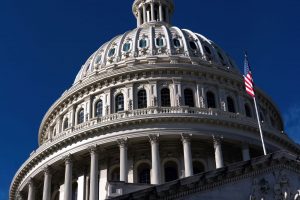
Woodward: Bridges & budgets worry infrastructure pros
One year after the Francis Scott Key Bridge crumbled into the Patapsco River in Baltimore, killing six people, the American Society of Civil Engineers released its latest report on the state of America’s bridges, roads, rail and other infrastructure.
While the news in ASCE’s 2025 Report Card for America’s Infrastructure was mainly good — an overall grade of C for the nation’s vital infrastructure, the highest since 1998 — issues still keep infrastructure experts up at night.
“Bridges. We’re just not repairing it at the state we should.”
Kevan Stone answered the “What keeps you up at night?” question during an infrastructure roundtable hosted by InsideSources to review the ASCE report.
As the CEO and executive director of the National Association of County Engineers (NACE), Stone and his organization deal with America’s infrastructure issues at the most local level, from building roads to sewer and wastewater. Stone said that while drone technology and artificial intelligence offer safer and more efficient ways to assess bridges (“We don’t have to put our workers on a boom and send them seven stories in the air”), fixing the problems they find still costs money.
“There are a million different reasons why (the needed work) is not being done,” Stone said. “But it’s not being done, and it’s going to lead to tragedy.”
One reason is the disconnect between the need for investment and reliable funding, said Alex Muresianu, senior tax policy analyst with the Tax Foundation.
Most Americans assume their gas taxes and ticket fees cover the costs of keeping roads repaired and the control towers operating. However, Muresianu noted that much of the spending in the Infrastructure Investment and Jobs Act (IIJA) spending wasn’t covered by transportation revenues but instead came from the general fund.
“We mostly financed the IIJA by putting it on the credit card.”
Why? Because the federal gas tax hasn’t been raised since 1993 (it’s 18.4 cents per gallon) and, thanks to inflation, has lost about half of its spending power. A $1 million expense in 1993 costs more than $2.2 million to cover today.
“I think by 2034, less than half of the projected spending on highways are projected to be covered by gas tax and other associated fees,” Muresianu said. That’s on top of the almost $300 billion transferred from the general fund to the Highway Trust Fund over the past 15 years, he added.
Stone said one area where the shortfall can be addressed is commercial trucking. While 18-wheelers pay more taxes and fees than typical cars and trucks, they also inflict far more wear and tear on roadways. Taxpayers are being asked to cover that gap between the taxes truckers pay and their effect on highways.
That gap is only going to get bigger, said Stone, if the federal government agrees to a proposal from the trucking industry to lift the current cap on the allowable weight for commercial tractor-trailers. The current cap is 80,000 pounds gross vehicle weight. Proposals are being made to raise that to 88,000 pounds or even more.
Stone noted a recent study showing that if bridges must be brought up to the standards required for these heavier trucks, “The cost would be in the hundreds of billions of dollars.”
So, perhaps it wasn’t surprising that Dean Franks with the American Transportation and Road Builders Association said “funding uncertainty” is his top concern.
“How do we generate the revenue to continue the good work that was done in the IIJA? Just to meet the needs identified in the new ASCE report card?” Franks asked. “Just to continue investment levels for highways, bridges and transit, we’re going to need $250 billion — so, a quarter of a trillion dollars on top of the user fee revenue that’s projected to come in to pay for the next five-year surface reauthorization bill.”
Part of the revenue solution might be to go to a vehicle mileage tax rather than relying on gasoline taxes, mainly as more Americans buy electric vehicles.
“As EV’s get more common, the use of a gas tax as a user charge for highway construction is less and less workable,” Muresianu said.
“Moving to a vehicle miles traveled tax could eliminate the problems, not only with EV’s shrinking the tax base, but if it’s adjusted for vehicle weight, better capture the increased maintenance costs from larger, heavier trucks.”
And, said Ted Greener with the Association of American Railroads, those trucks already have electronic logging devices in the cab that could be used to calculate their mileage.
“Let’s see how we can help alleviate what is an underpayment over there,” Greener said. “Because whatever one thinks of whether you know my mom or yours should be paying for their full use of the road, I would imagine, most Americans would agree that large multinational corporations using the highways and roads and bridges in this country should be paying for that.”
While freight rail and trucking are viewed as competitors, Greener said the two industries share the same goals in terms of infrastructure.
“This isn’t an anti-truck exercise,” Greener said. “They already pay a ton in taxes.”
“The rail industry cares greatly about the state of our nation’s highways and bridges,” Greener said. “The trucking sector happens to be our largest competitor, but they’re also our largest customer.”
It doesn’t behoove us, or the American public, for highways to be in anything less than a good state.
Chris Woodward writes about industry and technology for InsideSources.com.

